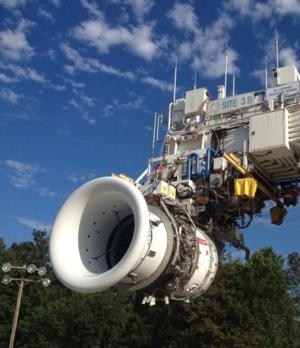Tue, Sep 10, 2013
Achieved Full Take-Off Thrust In The First Of A Comprehensive 60-Engine Test Program
CFM International has initiated testing of the first full LEAP engine, launching an extensive ground and flight test certification program that will encompass 60 engine builds over the next three years. The program will culminate in engine certification in 2015 and first entry into commercial service on the Airbus A320neo in 2016.

The LEAP-1A engine, which is the powerplant for the Airbus A320neo, fired for the first time on September 4th, two days ahead of the schedule. After a series of break-in runs, the engine was operating smoothly and has reached full take-off thrust. “In the past five years, we have completed thousands of hours of component testing leading up to this day,” said Chaker Chahrour, executive vice president of CFM International. “Everything we have seen tells us the LEAP engine is going to deliver all we promised, and much more. Now, we get to put it through its paces in the most comprehensive test program we have ever undertaken. By the time this engine enters services, we will have simulated more than 15 years of airline service with 60 different engine builds.”
The engine, which shares common turbomachinery with the LEAP-1C, is installed at Site 3B at GE’s Peebles, Ohio, outdoor test facility, where it will be on test for the next several weeks. The overall certification program, which encompasses all three LEAP engine variants, includes 28 ground and CFM flight test engines, along with a total of 32 flight test engines for Airbus, Boeing, and COMAC. Over the next three years, these engines will accumulate approximately 40,000 hours (18,000 engine cycles) leading up to entry into service.
“This is an exciting day for us,” said Cédric Goubet, executive vice president for CFM. “We are very proud of the fact that we have had 21 entries into service in our history; each of them was as on time and met all the specifications. From everything we have seen so far, the LEAP program is going to maintain that record.
”We believe we have the best team in aviation. Today, we thank each member for their tireless dedication to this project and congratulate them for the phenomenal job they have done in keeping this program on schedule. In fact, the first engine to test was actually two days ahead of the planned target to fire date we set nearly three years ago.”
(Image provided by CFM Engines)
More News
With Testing Soon Complete, Launch Preparations Begin in Earnest Sierra Space's Dream Chaser has been put through the wringer at NASA's Glenn Armstrong Test Facility in Ohio, but w>[...]
Takeoff Roll The process whereby an aircraft is aligned with the runway centerline and the aircraft is moving with the intent to take off. For helicopters, this pertains to the act>[...]
“We’re proud of the hard work that went into receiving this validation, and it will be a welcome relief to our customers in the European Union. We couldn’t be mor>[...]
"Aircraft Spruce is pleased to announce the acquisition of the parts distribution operations of Wag-Aero. Wag-Aero was founded in the 1960’s by Dick and Bobbie Wagner in the >[...]
IDENT Feature The special feature in the Air Traffic Control Radar Beacon System (ATCRBS) equipment. It is used to immediately distinguish one displayed beacon target from other be>[...]
 Sierra Space Repositions Dream Chaser for First Mission
Sierra Space Repositions Dream Chaser for First Mission ANN's Daily Aero-Term (05.10.24): Takeoff Roll
ANN's Daily Aero-Term (05.10.24): Takeoff Roll Aero-News: Quote of the Day (05.10.24)
Aero-News: Quote of the Day (05.10.24) Aero-News: Quote of the Day (05.11.24)
Aero-News: Quote of the Day (05.11.24) ANN's Daily Aero-Term (05.11.24): IDENT Feature
ANN's Daily Aero-Term (05.11.24): IDENT Feature



